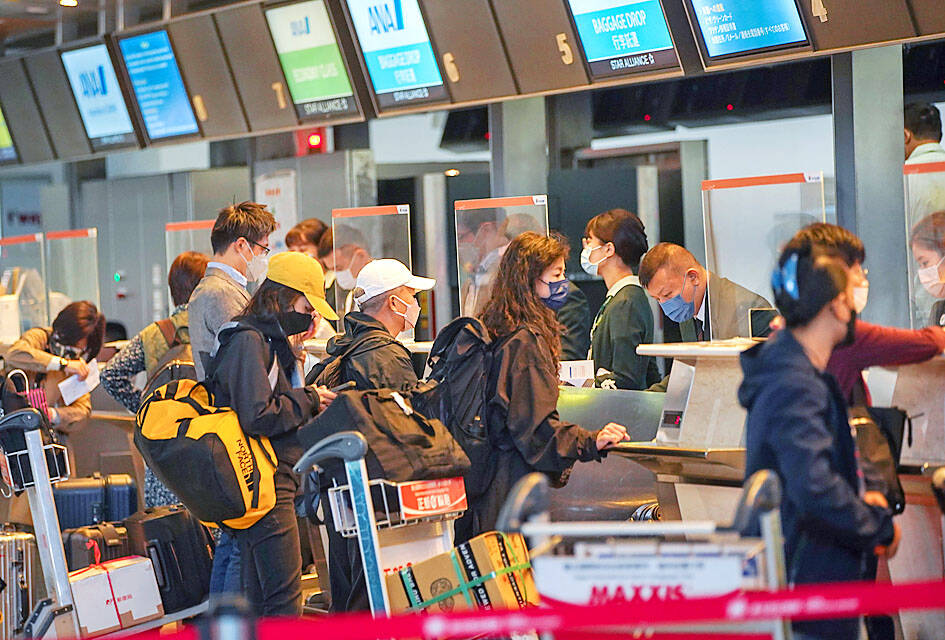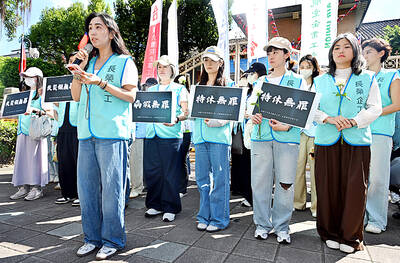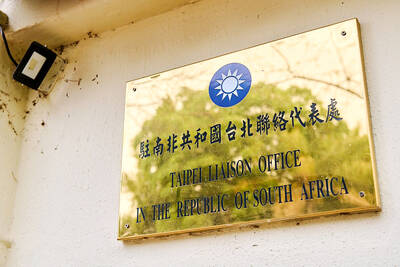The Central Epidemic Command Center (CECC) yesterday said it would not reverse its COVID-19 policies, as it announced its five main goals for “living with the virus.”
Deputy Minister of Health and Welfare Victor Wang (王必勝), who heads the center, said that the number of new local cases for last week had reached 323,443 as of Saturday — 9.1 percent higher than a week earlier.
The number of new daily cases “is still at a plateau in Taiwan, so we advise people to continue practicing preventive measures,” he said.

Photo: CNA
Local media reported that Chan Chang-chuan (詹長權), a professor at National Taiwan University’s College of Public Health, said that “Taiwan’s new direction for COVID-19 prevention is unclear.
The CECC in April announced that it would change its policy from “zero COVID-19” to “living with the virus,” also known as the “New Taiwan model,” Wang wrote on Facebook on Monday.
“2022 is the COVID-19 disaster year for Taiwan,” Wang wrote, adding that more than 6.8 million confirmed local cases, including 11,511 deaths, had been reported in the six months since the new policy had been launched.
He wrote that COVID-19 might be one of the top five causes of death in Taiwan this year, and that the outbreak of the Omicron variant of SARS-CoV-2 showed that the CECC’s measures could not effectively suppress case numbers and deaths at the level required to live with the virus.
“The key point [of the New Taiwan model] is ‘manageable,’” Wang said, adding that there are five main goals for “living with the virus.”
The goals include keeping the severe COVID-19 and fatality rates at manageable levels, maintaining sufficient healthcare capacity, protecting the most vulnerable groups, making the procedures for people who need to receive treatment and medication more efficient, and enabling people to return to their normal lives and restoring economic growth, he said.
Compared with 12 Organisation for Economic Co-operation and Development countries, Taiwan’s COVID-19 case fatality rate is 0.17 percent, or the fifth-lowest, while the COVID-19 mortality rate is 480.8 per million, or the fourth-lowest, Wang said.
The percentage of severe cases has remained about the same throughout this year’s outbreaks of the Omicron variant, and although the new daily caseload has plateaued, the Omicron BA.5 subvariant has affected Taiwan slower than in many other countries, he said, adding that the severe case rate continues to drop.
“We regret and feel sad about each life lost, and we understand the feelings of their family members,” Wang said.
However, as more than 90 percent of the COVID-19 deaths had comorbidities, so in terms of “excess mortality” — the difference between the observed numbers of deaths and expected number of deaths without the influence of COVID-19 in a specific time period — Taiwan ranked third lowest in the world, he said.
“I’m not sure what the academic meant by needing ‘low daily caseloads to live with the virus.’ Does it mean we need to impose lockdowns or strive for ‘zero COVID’ like China?” Wang said. “But I am sure we are not turning back.”
He said the data he presented showed that Taiwan had done well in COVID-19 prevention and response, thanks to the collective efforts of the public.
The CECC yesterday reported 41,364 new local cases, 74 imported cases and 36 deaths.
It said that 89.5 percent of the local cases sequenced last week were infected with the BA.5 subvariant.

A drunk woman was sexually assaulted inside a crowded concourse of Taipei Railway Station on Thursday last week before a foreign tourist notified police, leading to calls for better education on bystander intervention and review of security infrastructure. The man, surnamed Chiu (邱), was taken into custody on charges of sexual assault, taking advantage of the woman’s condition and public indecency. Police discovered that Chiu was a fugitive with prior convictions for vehicle theft. He has been taken into custody and is to complete his unserved six-month sentence, police said. On Thursday last week, Chiu was seen wearing a white

The Taoyuan Flight Attendants’ Union yesterday vowed to protest at the EVA Air Marathon on Sunday next week should EVA Airway Corp’s management continue to ignore the union’s petition to change rules on employees’ leave of absence system, after a flight attendant reportedly died after working on a long-haul flight while ill. The case has generated public discussion over whether taking personal or sick leave should affect a worker’s performance review. Several union members yesterday protested at the Legislative Yuan, holding white flowers and placards, while shouting: “Life is priceless; requesting leave is not a crime.” “The union is scheduled to meet with

‘UNITED FRONT’ RHETORIC: China’s TAO also plans to hold weekly, instead of biweekly, news conferences because it wants to control the cross-strait discourse, an expert said China’s plan to expand its single-entry visa-on-arrival service to Taiwanese would be of limited interest to Taiwanese and is a feeble attempt by Chinese administrators to demonstrate that they are doing something, the Mainland Affairs Council said yesterday. China’s Taiwan Affairs Office (TAO) spokesman Chen Binhua (陳斌華) said the program aims to facilitate travel to China for Taiwanese compatriots, regardless of whether they are arriving via direct flights or are entering mainland China through Hong Kong, Macau or other countries, and they would be able to apply for a single-entry visa-on-arrival at all eligible entry points in China. The policy aims

COUNTERMEASURE: Taiwan was to implement controls for 47 tech products bound for South Africa after the latter downgraded and renamed Taipei’s ‘de facto’ offices The Ministry of Foreign Affairs is still reviewing a new agreement proposed by the South African government last month to regulate the status of reciprocal representative offices, Minister of Foreign Affairs Lin Chia-lung (林佳龍) said yesterday. Asked about the latest developments in a year-long controversy over Taiwan’s de facto representative office in South Africa, Lin during a legislative session said that the ministry was consulting with legal experts on the proposed new agreement. While the new proposal offers Taiwan greater flexibility, the ministry does not find it acceptable, Lin said without elaborating. The ministry is still open to resuming retaliatory measures against South